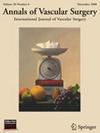Use of Cryopreserved Arterial Allografts as a Reconstruction Strategy in Peripheral Sarcoma Surgery
IF 1.6
4区 医学
Q3 PERIPHERAL VASCULAR DISEASE
引用次数: 0
Abstract
Background
Complete resection of lower limb soft tissue sarcoma may require vascular resection and reconstruction. While prosthetic grafts and autologous saphenous veins are commonly employed, superior patency has been described for autologous veins. However, their use implies harvesting, mostly on the contralateral limb. Limited data exist on the use of cryopreserved arterial allografts for such vascular replacement.
Methods
We report a retrospective series of 11 patients with locally aggressive extremity sarcomas undergoing 20 vascular resections and reconstructions with cryopreserved arterial allografts over a 5-year period. A total of 10 arteries and 10 veins were reconstructed. The mean tumor length on resected specimen was 15.4 cm, with the thigh being the most frequent site of resection. Six patients required additional osseous reconstruction with mega-implants or bone allograft.
Results
Limb salvage was achieved in 91% of patients. One amputation was necessary because of untreatable infection following fracture of a bone allograft in an irradiated area. The 1-year secondary arterial patency was 78%, with one graft requiring revision due to a mechanical friction on a mega-implant. The 1-year venous patency was 69%.
Conclusion
Our series represents the first homogeneous cohort treated with cryopreserved arterial allografts for vascular reconstruction in sarcoma surgery, showing favorable outcomes despite extensive resection characteristics. Their use avoids contralateral limb morbidity and offers promising patency and limb-salvage outcomes.
低温保存动脉异体移植物作为周围性肉瘤手术重建策略的应用。
目的:下肢软组织肉瘤的完全切除可能需要血管切除和重建。虽然通常采用假体移植物和自体隐静脉,但自体静脉有明显的开放性。然而,它们的使用意味着收获,主要是在对侧肢体上。关于使用低温保存的动脉同种异体移植物进行此类血管置换的数据有限。方法:我们报告了11例局部侵袭性肢体肉瘤患者的回顾性研究,在5年的时间里,他们接受了20次血管切除和低温保存动脉异体移植重建。共重建10条动脉和10条静脉。切除标本的平均肿瘤长度为15.4 cm,大腿是最常见的切除部位。6例患者需要使用巨型植入物或同种异体骨移植进行额外的骨重建。结果:91%的患者获得肢体保留。一次截肢是必要的,因为无法治疗的感染后骨折的异体骨移植在辐照区。1年继发动脉通畅率为78%,其中一例由于大型种植体的机械摩擦需要翻修。1年静脉通畅率为69%。结论:我们的研究是第一个采用低温保存的同种异体动脉移植在肉瘤手术中进行血管重建的同质队列,尽管有广泛切除的特点,但仍显示出良好的结果。它们的使用避免了对侧肢体的发病率,并提供了有希望的开放和肢体保留的结果。
本文章由计算机程序翻译,如有差异,请以英文原文为准。
求助全文
约1分钟内获得全文
求助全文
来源期刊
CiteScore
3.00
自引率
13.30%
发文量
603
审稿时长
50 days
期刊介绍:
Annals of Vascular Surgery, published eight times a year, invites original manuscripts reporting clinical and experimental work in vascular surgery for peer review. Articles may be submitted for the following sections of the journal:
Clinical Research (reports of clinical series, new drug or medical device trials)
Basic Science Research (new investigations, experimental work)
Case Reports (reports on a limited series of patients)
General Reviews (scholarly review of the existing literature on a relevant topic)
Developments in Endovascular and Endoscopic Surgery
Selected Techniques (technical maneuvers)
Historical Notes (interesting vignettes from the early days of vascular surgery)
Editorials/Correspondence

 求助内容:
求助内容: 应助结果提醒方式:
应助结果提醒方式:


